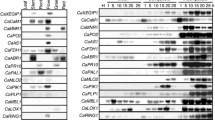Abstract
Death and browning of plant cells and tissues are common symptoms in plants infected with pathogenic fungi. When such symptoms become extensive an infected plant is regarded as susceptible; when they become limited a plant is described as resistant. An extreme example of resistance associated with death of plant cells is the hypersensitive reaction, where only one, or at most, a few dead cells are associated with very restricted growth of the pathogen. In contrast, extreme susceptibility is seen as a large volume of rotting tissue, which increases in size as the pathogen continues to grow. The present paper outlines how symptom development can be explained in terms of the types of cell death that occur. In particular, it considers the ability of fungal toxins to kill cells and how interactions between the killed cells and surrounding healthy tissues can determine continued or restricted growth of plant pathogenic fungi.
Access this chapter
Tax calculation will be finalised at checkout
Purchases are for personal use only
Preview
Unable to display preview. Download preview PDF.
Similar content being viewed by others
References
Bailey JA (1982) Mechanisms of phytoalexin accumulation. In: Bailey JA, Mansfield JW (eds) Phytoalexins. Blackie and Son, Glasgow, 289–318
Bailey JA, Mansfield JW (1982) Phyto alexins, Blackie and Son, Glasgow, p. 334
Bell JN, Ryder TB, Wingate VPH, Bailey JA, Lamb CJ (1986) Differential accumulation of plant defense gene transcripts in a compatible and incompatible plant-pathogen interaction. Mol Cell Biol 6:1615–1623
Collinge DB, Slusarenko AJ (1987) Plant gene expression in response to pathogens. Pl Mol Biol 9:389–410
de Wit PJM (1986) El i ci tati on of Active Resistance Mechanisms. In: Bailey JA (ed) Biology and Molecular Biology of Plant Pathogen Interactions. Springer-Verlag, Berlin, 149–169
Hargreaves JA (1981) Accumulation of phytoalexins in cotyledons of French bean (Phaseolus vulgaris L.) following treatment with Triton (t-octylphenol polyethoxyethanol) surfactants. New Phytol 87:733–741
Hargreaves JA, Bailey JA (1978) Phytoalexin production by hypocotyls of Phaseolus vulgaris in response to constitutive metabolites released by damaged cells. Physiol Pl Pathol 13:89–100
Heath MC (1981) A generalized concept of host-parasite specificity. Phytopathology 71:1121–1123
Mayama S, Tani T, Ueno T, Midland SL, Sims JJ, Keen NT (1986) The purification of victorin and its phytoalexin elicitor activity in oat leaves. Physiol Pl Pathol 29:1–19
O’Connell RJ, Bailey JA, Richmond DV (1985) Cytology and physiology of infection of Phaseolus vulgari s by Colleto-trichum lindemuthianum. Physiol Pl Pathol 27:75–98
O’Connell RJ, Bailey JA (1988) Differences in the extent of fungal development, host cell necrosis and symptom expression during race-cultivar interactions between Phaseolus vulgaris and Colletotrichum lindemuthianum. Pl Pathol (In Press)
Rahe JE (1973) Occurrence and levels of the phytoalexin phase-ollin in relation to delimitation at sites of infection of Phaseolus vulgaris by Colletotrichum lindemuthianum. Canad J Bot 51:2423–2430
Scheel D, Hauffe KD, Jahnen W, Hahlbrock K (1986) Stimulation of phytoalexin formation in fungus infected plants and el i ci tor-treated cell cultures of parsley. In: Lugtenberg B (ed) Recognition in Microbe-Plant Symbiotic and Pathogenic Interactions. Springer-Verlag, Berlin, 325–331
Ward EWB (1986) Biochemical mechanisms involved in resistances of plants to fungi. In: Bailey JA (ed) Biology and Molecular Biology of Plant-Pathogen Interactions. Springer-Verlag, Berlin, 107–131
Wijesundera RLC, Bailey JA, Byrde RJW (1984) Production of pectin lyase by Col1etotrichum lindemuthianum and in infected bean (Phaseolus vulgaris) tissue. J Gen Microbiol 130:285–290
Author information
Authors and Affiliations
Editor information
Editors and Affiliations
Rights and permissions
Copyright information
© 1989 Springer-Verlag Berlin Heidelberg
About this paper
Cite this paper
Bailey, J.A., O’Connell, R.J. (1989). Plant Cell Death: A Determinant of Disease Resistance and Susceptibility. In: Graniti, A., Durbin, R.D., Ballio, A. (eds) Phytotoxins and Plant Pathogenesis. NATO ASI Series, vol 27. Springer, Berlin, Heidelberg. https://doi.org/10.1007/978-3-642-73178-5_21
Download citation
DOI: https://doi.org/10.1007/978-3-642-73178-5_21
Publisher Name: Springer, Berlin, Heidelberg
Print ISBN: 978-3-642-73180-8
Online ISBN: 978-3-642-73178-5
eBook Packages: Springer Book Archive




